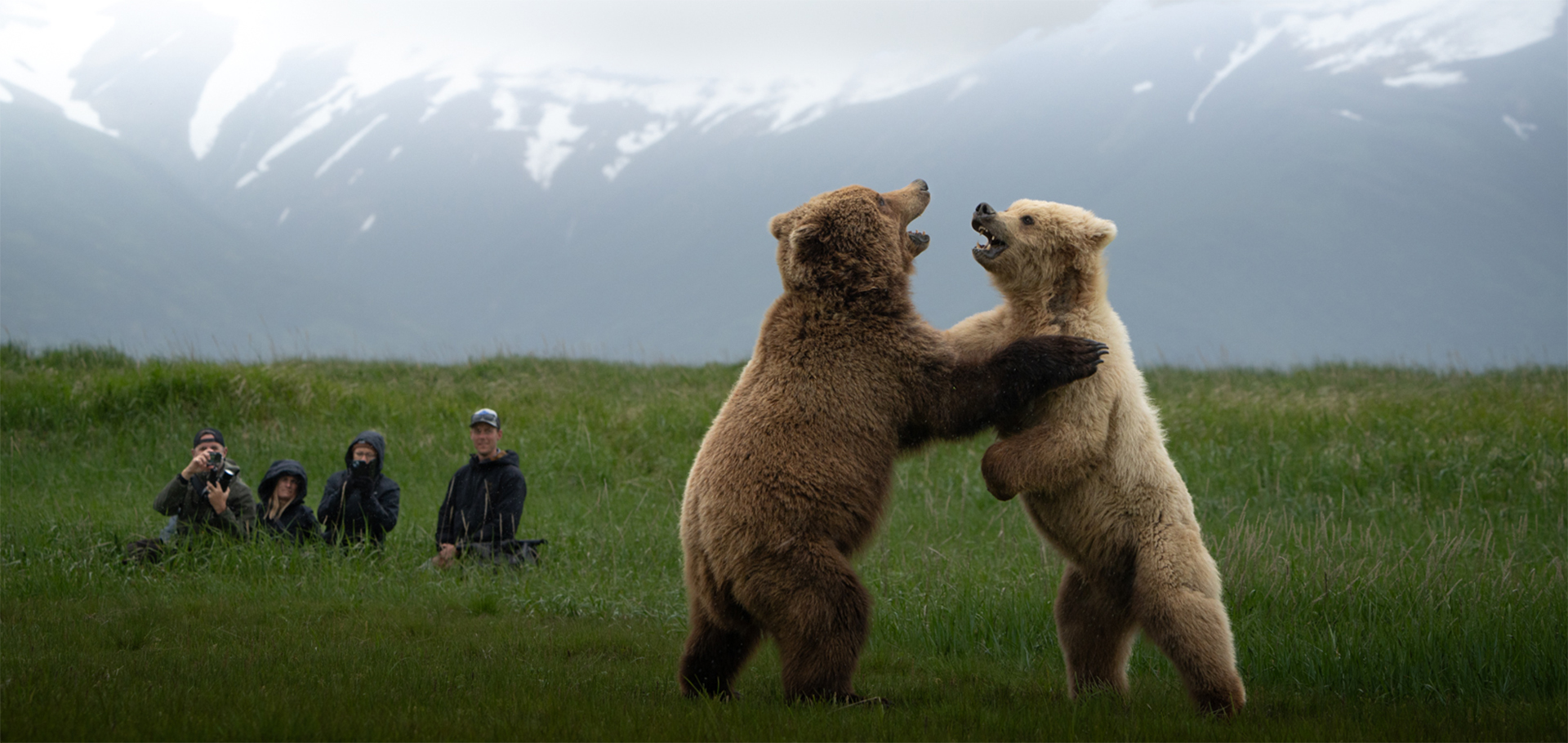By Nat Hab Expedition Leader Justin Gibson
In the heart of Alaska’s Bear Coast, where towering volcanoes meet intertidal sedge meadows fractured by braided rivers, lies an ancient bond where humanity and the wild ignite. It’s a place where the pulse of nature beats strongest, where the responsibilities of bear guiding become a sacred stewardship of a fragile ecosystem.

Nat Hab Expedition Leader Justin Gibson
I vividly recall my first immersion into this world, entrusted with the safety of a group amidst the awe-inspiring presence of brown bears. The raw connection to the wilderness, stripped of modern distractions, felt like a journey back millennia to a time when our survival depended on understanding and respecting the Earth and its creatures. Guiding along the bear coast, I’ve witnessed in others’ eyes the blend of wonder, awe, and the edge of fear—emotions that mark the threshold where magic thrives.

© Justin Gibson
Natural Habitat Adventures bestowed upon us the privileged duty: to train the next generation in the art of bear viewing ethics—a tradition steeped in wisdom passed down from Larry Aumiller to Drew Hamilton and Brad Josephs, and later, to me. It was time to pay it forward, ensuring the next generation of bear guides understood this delicate dance of understanding and respect. We delved deep into the nuances of bear communication, deciphering their subtle signals and the unspoken rules that govern their interactions.

In the busiest part of the year, Nat Hab allowed us to take the time to train these aspiring bear guides. A full week is dedicated to instilling the ethos of bear viewing, ensuring that our interactions with these magnificent creatures remain ethical and do not lead to behavioral changes. We spent all day in the crisp bite of wilderness air, stirring our senses and grounding us in the untamed environment we fiercely seek to protect. During meals, conversations wove intricate patterns around the dance of bear behavior—how their seemingly nonchalant demeanor belied a keen awareness of their surroundings and the intricate boundaries of their personal space. Navigating within this bear world is an honor and a very deep responsibility.

© Justin Gibson
Alaska’s Bear Coast is a testament to nature’s remarkable resilience. Here, high-density bear populations thrive in harmony, sustained by rich food sources like salmon, intertidal sedge meadows, and clams. It’s a reflection of the adaptability and social dynamics of these creatures, where sharing resources becomes a dance of survival—a spectacle of complex communication and tolerance rarely seen elsewhere.

Bear-to-bear habituation is a prime example of this social flexibility. In this high-density population, bears have developed a remarkable tolerance for each other, allowing them to forage in close proximity without constant conflict. The sight of bears fishing side by side, mere feet apart at places like Brooks Falls, is evidence of this unique form of coexistence.

© Justin Gibson
Equally fascinating is the interplay between bears and humans. Over time, bears in protected areas like the Bear Coast have acclimatized to human presence, learning to coexist peacefully with respectful visitors. This bear-to-human habituation is a delicate dance of trust, illustrating how our perceptions of each other can evolve when fear gives way to respect and curiosity. In these sanctuaries, bears have come to see humans not as threats but as predictable entities that can be safely ignored.

© Justin Gibson
But this transcends mere observation; it’s a narrative of transformation. As fear dissipates, replaced by reverence, we discover a shared kinship with bears. Human-to-bear habituation occurs when repeated encounters with bears at close range erode our initial wariness. As we learn to see these animals not as threats but as fellow inhabitants of this planet, our connection deepens. We become part of the wilderness, not apart from it.

© Justin Gibson
Watching the new guides absorb these lessons, I see reflections of my own journey—the rush of encountering a bear, the silent communion with nature that reshapes one’s perspective. The week of training wasn’t just about imparting knowledge; it was about kindling a fire within them, a passion for the wild, and a commitment to its preservation.

© Justin Gibson
Our week of training culminated not just in shared knowledge but in a profound sense of camaraderie and purpose. Each guide departed not only with skills but with a deep reverence for the wilderness and its inhabitants—a commitment to protect and preserve—a sacred promise passed down through generations.
As I reflect on this continuum—from mentors past to the stewards of today—I am reminded that our work is more than a job; it’s a legacy. A vocation rooted in passion and an unyielding commitment to safeguarding this pristine ecosystem. It’s about honoring those who came before us and preparing those who will follow, ensuring that the wildness we cherish endures.

The Bear Coast isn’t merely a location on a map; it embodies the essence of our planet’s untamed beauty and resilience. One of Earth’s last great Edens, it beckons us to embrace our role as custodians to safeguard its wonders for generations yet to come. In this shared journey of discovery and stewardship, we find ourselves woven into a narrative as ancient and enduring as the land itself—a testament to the wildness that resides within us all.
So, as we pass on this legacy, we do so with the knowledge that we are part of something bigger, something timeless. The Bear Coast, with its roaring rivers and towering volcanoes, its salmon-rich streams and bear-dense woods, stands as an all-important beacon of the untamed world. As long as there are those willing to listen, to learn and to protect, its story will continue to unfold—wild and unbroken.

© Justin Gibson































